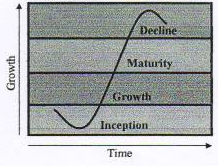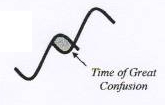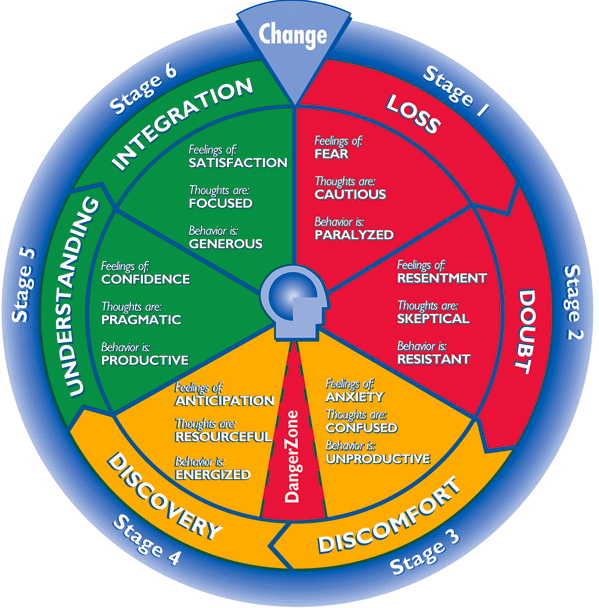"If you're in a bad situation, don't worry - it'll change.
If you're in a good situation, don't worry - it'll change."John A. Simone, Sr.
How accurately this quote sums up life! It highlights the importance of understanding that change is the only constant - the one thing in life we can count on to happen. It’s important to remember three things about change:
-
Change will always happen – what is important to know is which stage of change you are currently in.
-
No matter how negative you perceive the change to be, there is always room for positive growth and learning.
-
No matter how positive you perceive the change to be, it is always stressful.
"Any change, even a change for the better, is always
accompanied by drawbacks and discomforts."Arnold Bennett
When change happens, you have to weigh up your options and decide whether you are going to be a victim or victor of change.
A victim of change believes that they do not have enough skills and that the demands of change are too much to cope with. They allow circumstances (and other people) to influence them and, therefore, feel they lack control in the change process.
A victor of change believes they have enough skills to cope with the demands of change. They attempt to impact on the change by using their sphere of influence and control, thereby feeling in control of the change process.
Take the example of two employees who, as part of their salary package, were each given a run-down company house to live in. After a year, the first employee had improved his house by cleaning out the gutters, fixing the gate, tidying up the garden, painting the walls etc. He now has a nice house to live in and is a Victor of change.
The second employee spent the year complaining about the terrible state of the house. He has done nothing to improve its condition and is thus still living in a run-down house. He is a Victim of Change.
Life is about positive and negative experiences. Sometimes we cannot control the experiences themselves, but we can control how we choose to deal with those experiences.
"You must welcome change as the rule but not as your ruler."
Dennis Waitley
What is the Impact of Beliefs on the Experience of Change?
To understand the experience of change, we can examine the 4 factors which determine our reaction to change. They are:
-
Performance – the way in which we behave, what we do (or don’t) say, and what we do (or don’t) do.
-
Emotions – the way we feel about ourselves, our jobs, our families etc.
-
Beliefs – what we think about - and the meaning we attribute to - ourselves, others and the environment around us, and our perceptions and interpretations of this reality.
-
Experiences – the events and situations in which we find ourselves.
Different people deal with the same situations in different ways. Why? Because our behaviour is influenced not only by the situation or event that we experience, but by our beliefs and emotions too.
People tend to think that the event causes our behaviour. If ‘X’ happens we will do ‘Y’.
For example: “If my wife cheats on me, I’ll leave her.” Or “If my husband hits me, I’ll leave him.” But they forget about beliefs and emotions - and beliefs and emotions change everything. If the husband hits her the wife doesn’t leave, because she loves him, because she believes she won’t find anyone better, because she thinks she can’t cope without him…. etc.
Individuals experience the same situations in different ways – there is no 'reality'. Our response depends on our beliefs and feelings (our perceptions).
Example: It is raining. There have been weeks of hot sunny days, but now it’s Saturday morning and it’s raining. Is that good or bad?
If you are a farmer who has just planted his crops, you will know it is the best thing for your crops. You will feel happy (feeling) and might even go out to your fields in the rain laughing (behaviour).
If you are a bride on her wedding day and you planned to have a garden wedding, you will think your day has been ruined. You will be bitterly disappointed (feeling) and you will probably cry (behaviour).
These examples show us how the same event is experienced in different ways by different individuals because of our beliefs and emotions. There is no objective reality - reality is based on our perceptions.
In the same way, the process of change is also experienced differently by different people. How you respond to change depends on your beliefs and emotions. Beliefs drive our emotions and emotions drive our response.
Example: A team gets a new manager. He is young and inexperienced.
|
Belief |
If he doesn’t have experience, he will not be able to do the job properly. He will not know what he is doing and will be the downfall of this department. |
He may not have experience, but he has been trained to do the job, so will be able to do it. If we give him a chance he might improve things in this department. |
|
Emotion |
Insecure |
Secure |
|
Behaviour |
Uncooperative |
Cooperative |
What we believe about the change will determine our experience of the change. Are you a victim or a victor of change? It’s YOUR choice.
The Story of Viktor Frankl
Viktor Frankl was a Jewish psychiatrist born in 1905 who lived in Vienna. As a young boy he was deeply interested in the meaning and purpose of human existence.
During WW2, at the age of 39, he was captured by the Germans and sent to a number of Nazi concentration camps, including the two most notorious - Auschwitz & Dachau. He remained in these camps until the end of the war.
Prisoners in concentration camps were deprived of everything which, in normal circumstances, contributes to a loss of psychological wellbeing, dignity and worth. Yet it was in precisely these most adverse conditions that Frankl became convinced of the significant role of values in people’s lives. Having something to live for was what enabled prisoners to hold on to the will to live in circumstances that made death seem like a solution.
Frankl believes in the (indestructible) significance of life. Death for Frankl is the boundary which makes life a unique, unrepeatable opportunity. He believes that life is given to us so that we can find meaning - even in suffering.
According to Frankl, suffering does not deprive us of the freedom to decide how we will deal with that suffering. If a situation cannot be changed, if suffering cannot be avoided, what is retained is the freedom to change ourselves. Suffering has meaning.
It offers us the opportunity to transcend adversity. By the way suffering is borne, a tragedy can be turned into a triumph. The freedom to live a life of worth and dignity remains, even in suffering.
"I can be changed by what happens to me, but I refuse to be reduced by it."
Maya Angelou
“The Whole is Greater Than the sum of its Parts”
The basic premise of what is known as the General Systems Theory, is that a system is a collection of parts that interact to function as a whole. We can use the example of a car engine to try to explain this. The parts of an engine all work together. Change one part and it affects the whole system. Example: Change the fuel from petrol to diesel and you have to change the way the whole engine works too.
It is the same with life. Our lives are a set of related systems – if there is a change in the external world, there must be a change within ourselves as well.
Let me tell you the story of how to catch a baboon.
Farmers catch baboons with a simple plan. They cut a small opening in a pumpkin (just big enough for a baboon’s hand), leaving the seeds inside. The baboon comes along and wants to get the seeds out. He starts by picking out a few seeds at a time, but then he becomes greedy and wants more and more, so he takes a bigger handful of seeds from the pumpkin. The farmer waits for the perfect opportunity – when the baboon has so many seeds in his hand that he can’t get his hand out of the pumpkin. The baboon sees the farmer coming and gets panic-stricken. He tries to run away, but he won’t let go of the seeds, and so he can’t get his hand out of the pumpkin. Because he won’t let go, he gets caught.
What is the lesson about change that we can learn from that story? That from time to time we need to let go of the old ways so as not to be caught unprepared when change happens.
"He who rejects change is the architect of decay. The only human institution that
rejects progress is the cemetery."Harold Wilson
The Sigmoid Growth Curve
The Sigmoid Growth Curve is an S-shaped curve that plots the life of all living things. It also plots the life of a business and of a relationship.
What this diagram shows is that every new life, every new organisation, every new relationship starts out faltering in the beginning (at its inception). Then it grows, enters a mature stage, before finally declining and perishing.
Example: A new born baby actually loses weight before it begins to grow. It then continues to grow, getting bigger and stronger, until old age when there is a decline.
This curve makes sense if we think about human life, but if we think about the life of an organisation or relationship it is pretty depressing! What it suggests is that all organisations and relationships will eventually just fizzle out.
Is that true? Does that have to happen?
No!
What is exciting is that people and companies can be proactive and can start their own new sigmoid curve. So BEFORE the decline starts, they make changes that will inject new life and longevity.
So what you get is this pattern:

The secret to continued growth is to start a new Sigmoid Curve before the old one goes into decline. The new curve must be started when the old one is still at the maturity stage. Then there will still be the time, resources and energy to get the new curve through its initial faltering stages.
The Impact of Change
What is the impact of change? It is about letting go.
-
Change implies a loss of control. You need to let go of the comfortable and current 'winning recipe'. We need to stop being comforted by the illusion that things will always be the same – today and in the future.
-
Change often implies a temporary dip in performance. The challenge is to minimise this impact.
-
Change is a process, not an event.
-
What works today will not necessarily work tomorrow.
-
You must let go of where you are to get where you are going.
-
Behaviours that demonstrate adaptability include the ability to:
-
Let go of assumptions
-
Tolerate uncertainty
-
Risk a new way of doing things
-
Be flexible
-
Take into account the multiple perspectives of a situation
-
Understand the “why” of change
-
Remember the baboon got caught because he didn’t let go. Change requires us to be flexible and adaptable.
"It may be hard for an egg to turn into a bird: it would be a jolly sight harder for it to learn to fly while remaining an egg.
You cannot go on indefinitely being just an ordinary, decent egg. We must be hatched or go bad."C. S. Lewis
The Six Stages Of Change
Think of changes that have occurred in your life – moving house, changing jobs, the village you grew up in changing and expanding, road names changing, the introduction of new technology (typewriters changing to computers, records to CDs to DVDs to MP3 etc.)
Do you like these changes? Did you embrace them straight away?
There are six different stages we all go through in response to change.

The Change Wheel above shows us the six different stages and gives us an idea of the thoughts, feelings and behaviour we can expect at each stage.
Stage 1: Loss
-
Loss – of how things have been done before;
-
Denial – the change is discounted.
Beliefs: Cautious
Feelings: Fear
Behaviour: Paralysed
Stage 2: Doubt
-
Questions and uncertainty emerge;
-
Anxiety causes fight/flight/freeze response;
-
Resistance.
Beliefs: Sceptical
Feelings: Resentment
Behaviour: Resistant
Stage 3: Discomfort
-
Making sense of change;
-
Planning how to get to the top of the change;
-
Reality check – resistance will not guarantee the status quo;
-
Feeling anger and frustration;
-
Attempt to minimise the perceived loss with psychological bargaining.
Beliefs: Confused
Feelings: Anxiety
Behaviour: Unproductive
At this stage, we enter the Danger Zone. It is here that we choose to be a Victim or Victor of change. We can either move on and discover the opportunities or choose to focus on the perceived loss. This is a return to Stage One.
Stage 4: Discovery
-
We start to see light at the end of the tunnel;
-
A sense of mastery over the change emerges;
-
We begin to realise the positive impact of the change;
-
We discover new meanings and understanding;
-
Letting go is a pre-requisite for discovery.
Beliefs: Creative
Feelings: Anticipation
Behaviour: Energised.
Stage 5: Understanding
-
The understanding of the change and its impact – loss and gain;
-
The 'why' of change.
Beliefs: Pragmatic
Feelings: Confidence
Behaviour: Productive
Stage 6: Integration
-
Change becomes an integrated experience;
-
We embrace the change;
-
We apply the lessons learned in becoming 'change fit';
-
We change the paradigm from scarcity to abundance.
Beliefs: Focused
Feelings: Satisfaction
Behaviour: Generous
"It is not the strongest of the species that survives, nor the most intelligent,
but the one most responsive to change."L. C. Megginson (frequently misattributed to Charles Darwin)
The Two Faces of Change
Always remember there is no 'reality'. Change is neither good nor bad - it always involves danger and opportunity.
Change involves danger because it begins with loss.
-
You have to let go of where you are, to get to where you want to be.
-
You have to leave something behind.
-
Whether a change is positive or negative, loss is always involved.
Change also always involves opportunity.
-
The opportunity may not be obvious or immediate. Sometimes you need to search for it.
-
Seeking the opportunity is a choice. This choice depends on your own attitude.
"If you don't like something change it;
if you can't change it, change the way you think about it.”Mary Engelbreit
Who is Best Able to Cope With Change?
It is important to know where you are on the Change Wheel, because, like Viktor Frankl, it is your attitude to your circumstances that will help you survive. The approach you take to change will influence how you view the change, and then how you will respond to the change.
Strong resistance to change is often rooted in deeply conditioned or historically reinforced feelings. Patience and tolerance are required to help people in these situations to see things differently. In addition, certain types of people - the reliable, dependable, steady, habitual, process-oriented types - often find change very unsettling.
People who welcome change usually exhibit character traits of mobility and adaptability. They are directly opposite to those people who possess traits of reliability and dependability (and who, therefore, are not as adept at coping with change).
Certain industries and disciplines have a high concentration of staff who need a strong reliability/dependability personality profile, for example, health services and nursing, administration, public sector and government departments, utilities and services; these sectors will tend to have many staff with character profiles who find change difficult.
The more you understand people's needs, the better you will be able to manage change. Be mindful of people's strengths and weaknesses. Not everyone welcomes change. Take the time to understand the people you are dealing with, and how and why they feel like they do, before you take action.
"The most successful people are those who are good at plan B."
James Yorke

